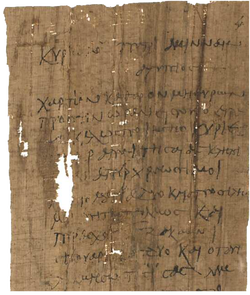 P.Abinn. 21
P.Abinn. 21 So, next time you go to grab that sticky note, be reminded that the ancients did not have such a luxury!
 P.Abinn. 21 P.Abinn. 21 Letter writers in the ancient world who chose papyrus as their written medium could use a new sheet of papyrus cut from a roll, or an already-inscribed papyrus. In many cases, when the recipient of a letter wished to respond to the sender, he/she would turn the letter over and write (or have a scribe write) his/her response on the back. In very rare cases, writers would wash the text off of a previously inscribed papyrus surface and then compose their letter. In these cases, it probably means that the respondent actually had no other material at his/her disposal. In other words, it was out of necessity that some papyri were re-used for inscription. We find a case of this detailed in one fourth century C.E. papyrus (P.Abinn. 21): "To my Lord and Father Abinnaeus, Alupios. Since I could not find at the moment a clean sheet of papyrus (χαρτίον καθαρὸν), I have written on this (i.e., the back of another letter)." Sometimes, blank papyrus sheets were actually sent directly to the correspondents. In one papyrus letter dated to the reign of Augustus (P.Wash.Univ. 2.106), Dionysia chastises her brother for not sending her a sheet of unwritten papyrus: "You did not send me word or remembrance or a sheet of unwritten papyrus (κόλλημα ἀγράφου). So write to me a letter and send it." And in another letter dated to the third century C.E. (P.Flor. 3.367), the letter writer complains that his would-be correspondent did not use the "letter-writing papyri" he sent him: "For I wrote to you many times and even sent letter-writing papyri (χάρτας ἐπιστολικο[ὺς) so that you would be supplied to write to me." Fresh, blank papyrus was, after all, not free, so it is understandable why this particular writer was frustrated. These sheets probably cost him good money. I suppose availability of new or "clean" papyrus also depended on one's location in relation to vendors, markets, and manufacturers of papyrus. Surely not everyone kept full papyrus rolls in their dwelling for future correspondence (though this is possible for the more well-to-do; on one request for papyrus rolls, see here, at bottom). It has often been stated that papyri could not be bought as individual sheets, but I hasten to agree with Bagnall and Cribiore's conviction that "people could find on the market papyrus stationary and could purchase individual pieces, whether whole sheets or not, and not only rolls" (Women's Letters from Ancient Egypt, 300 BCE – AD 800 [Ann Arbor: University of Michigan Press, 2006], 36). So, next time you go to grab that sticky note, be reminded that the ancients did not have such a luxury!
2 Comments
Jeremiah Coogan
8/4/2015 05:20:54
Without challenging the primary thrust of the post, I suggest that there's a better way to understand P.Wash.Univ. 2.106. Dionysian's complaint is not about her brother's failure to send blank sheets for her use. After all, she manages to send him a letter anyway. She is miffed because he didn't write to her, period. She objects that he didn't send even a short note, not even a blank page.
Reply
8/4/2015 06:42:32
That's an interesting take (the reference is, then, a rhetorical flare of sorts) and I suppose it is possible. However, requests for papyrus are attested in the documentary record. We know people frequently asked their friends or family members to buy and send them papyri (see here, e.g., at bottom: http://www.bricecjones.com/blog/book-review-coptic-documentary-texts-from-kellis-2-pkellis-vii). This precise issue comes up in Bagnall and Cribiore (2006), and P.Wash.Univ. 2.106 is cited there as an example of a request for papyrus sheets. Given such requests, I am inclined, along with Bagnall and Cribiore, to take the phrase “unwritten papyrus sheet” at face value, namely, Dionysia needed fresh, clean papyrus.
Reply
Your comment will be posted after it is approved.
Leave a Reply. |
Archives
August 2015
Categories
All
|